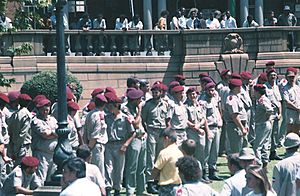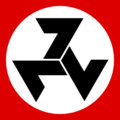Afrikaner Weerstandsbeweging facts for kids
The Afrikaner Weerstandsbeweging (AWB), which means "Afrikaner Resistance Movement", is a political group in South Africa. It is known for its strong Afrikaner nationalist and far-right views. The AWB was started in 1973 by Eugène Terre'Blanche and six others. Its main goal has been to create an independent republic for Afrikaner people, often called a "Volkstaat" or "Boerestaat", in parts of South Africa.
During the early 1990s, when South Africa was changing from Apartheid (a system of racial separation), the AWB was involved in violent actions against black South Africans. As of 2016, the group was reported to have about 5,000 members and uses social media to find new people.
Contents
History of the AWB
On 7 July 1973, Eugène Terre'Blanche, who used to be a police officer, held a meeting in Heidelberg, Gauteng, South Africa. He was unhappy with what he saw as "liberal views" from the Prime Minister at the time, B.J. Vorster, especially about racial issues. Terre'Blanche also worried about communist ideas spreading in South Africa.
He decided to form a group with six other people who thought like him. They called it the Afrikaner Weerstandsbeweging (AWB). Their aim was to promote Afrikaner and Christian nationalism. His friends chose him to lead the group, and he remained the leader until he passed away in April 2010.
The AWB wanted to create an independent "Boer State" just for Boer-Afrikaner people. They believed this state should be separate from Apartheid South Africa, which they thought was too liberal. The AWB wanted to bring back the independent Boer Republics that existed in the past, like the South African Republic and the Orange Free State, which they felt were lost after the Second Boer War. The group also held strong negative views towards Jewish people.
The Apartheid Era
During the 1970s and 1980s, the AWB gained thousands of white South African members. They were against changes to the apartheid laws in the 1980s. They often bothered politicians who supported reforms and held large, sometimes noisy, political gatherings. Terre'Blanche was a powerful speaker and used his skills to attract new members.
He strongly opposed the removal of "petty apartheid" laws. These laws included banning marriages between different races and preventing different racial groups from living in the same areas. He also disagreed with giving limited political rights to Indian and mixed-race (Coloured) people. During the "State of Emergency" in the mid-1980s, there were reports of AWB violence against non-white people. The AWB was especially against the African National Congress (ANC), which was illegal at the time. The ruling National Party saw the AWB as a small, extreme group.
The AWB operated quite freely until 1986. That year, white South African police officers used tear gas against the AWB for the first time when the group disrupted a National Party meeting. In 1988, it was thought that 5–7% of white South Africans supported the AWB. A documentary film from 2006 claimed the group had reached a peak of half a million supporters at its strongest point.
During the End of Apartheid

As South Africa moved towards its first non-racial election, the AWB was involved in violent actions.
In August 1991, during the Battle of Ventersdorp, the AWB clashed with police outside the town hall where President F. W. de Klerk was speaking. Several people were hurt or killed in this conflict. Later, during the talks about the future of South Africa, the AWB stormed the Kempton Park World Trade Centre where these important discussions were happening. They took over the main meeting hall, threatened the people there, and painted slogans on the walls before leaving. In July 1990, AWB members attacked the Vrye Weekblad newspaper office, which they accused of being too liberal. In March 1991, a series of attacks caused damage in the city of Ventersdorp.
In November 1993, the AWB made an agreement with the Inkatha Freedom Party. The AWB offered military training to the IFP, and they agreed that "Boer and Zulu would fight together for freedom and land" if they faced a common enemy.
In April 1994, AWB members attacked an American reporter from The New York Times, Michael Allen, while he was covering an AWB gathering in Rustenburg. The reporter was punched and kicked but was not seriously injured.
The Bophuthatswana Crisis
In 1994, just before South Africa became a democracy, the AWB became known internationally for trying to support the government of Lucas Mangope in the homeland of Bophuthatswana. AWB members, along with other Afrikaner militiamen, entered the capital city, Mmabatho, on 10 and 11 March. Black police officers and soldiers from Bophuthatswana, who were supposed to support President Mangope, left the streets in protest of the AWB's actions. They later turned against the militiamen at the airport in Mafikeng.
In Mmabatho, the AWB found themselves under attack from both the Bophuthatswana Defence Force and local citizens. As they tried to leave Mmabatho on 11 March, three AWB members were killed. Photojournalists and TV news crews recorded this event, which was very damaging to the AWB's public image and lowered the morale of its white members. The AWB claimed they were invited into the country to help the Bophuthatswana Government. However, an official investigation found that they entered without an invitation and were not welcome there.
After Apartheid Ended
On 17 June 2001, Terre'Blanche was sent to prison for six years for attacking a petrol station worker and trying to murder a security guard. He was released in June 2004 after serving three years. While in prison, he said he became a born-again Christian and claimed he had changed some of his extreme views, now speaking about reconciliation.
In April 2007, AWB posters appeared at an arts festival in Oudtshoorn. These posters mentioned a popular Afrikaans song and South Africa's old Coat of Arms. Organisers quickly removed the posters.
In March 2008, the AWB announced it was becoming active again, saying the public encouraged them. They listed reasons for their return, including problems with electricity, corruption in government, and high crime rates. They planned to demand land they believed was legally theirs based on old treaties, even taking their case to the International Court of Justice if needed. If that failed, they said they would use force. In April 2008, Terre'Blanche was scheduled to speak at several AWB meetings. They identified areas in South Africa that they believed should be part of a future "Volkstaat," including Vryheid in KwaZulu-Natal and parts of the Free State.
The Mail & Guardian newspaper reported in 2008 that the AWB group had over 5,000 members.
In 2010, Terre'Blanche was murdered on his farm by an employee. Steyn von Rönge was then announced as the new leader of the organisation.
Leaders of the AWB
| General Secretary | Took office | Left office |
|---|---|---|
| Eugène Terre'Blanche | 7 July 1973 | 3 April 2010 |
| Steyn von Rönge | 8 April 2010 |
The AWB in Fiction
The AWB is often used as a group of bad guys in books that imagine different historical outcomes. For example, in Harry Turtledove's novel The Guns of the South (1992), members of a made-up AWB are important characters. The AWB also plays a big part in Larry Bond's novel Vortex (1991), which describes a civil war in South Africa during the Cold War. It also appears in Richard Herman Jr.'s novel, Iron Gate (1996).
Gallery
-
Vierkleur, flag of the once independent South African Republic
-
Flag of South Africa (1928–1994), replacing the Union Jack with the Afrikaner Vryheidsvlag
-
Flag of South Africa (1928-1994), replacing the Union Jack with the flag of the AWB
See also
 In Spanish: Movimiento de Resistencia Afrikáner para niños
In Spanish: Movimiento de Resistencia Afrikáner para niños
- (Don't) touch me on my studio
Similar groups
- Boerestaat Party
- Vereniging van Oranjewerkers
- Boeremag
Separatism
- Orania
Documentary films
- His Big White Self
- The Leader, His Driver and the Driver's Wife
- Louis Theroux's Weird Weekends episode 3.3
- My Beloved Country (1991)





